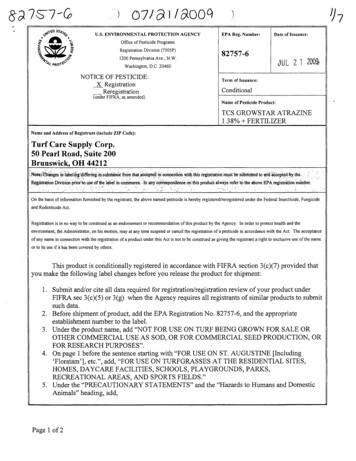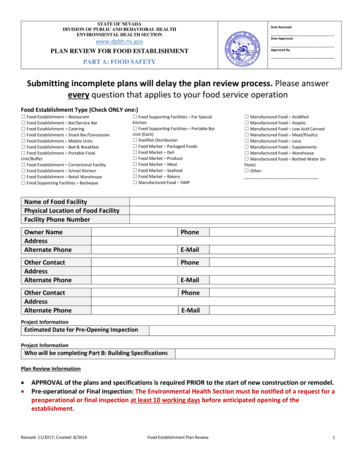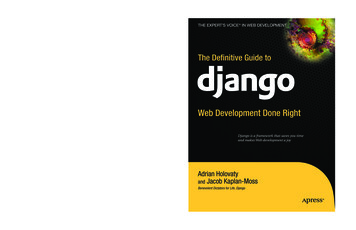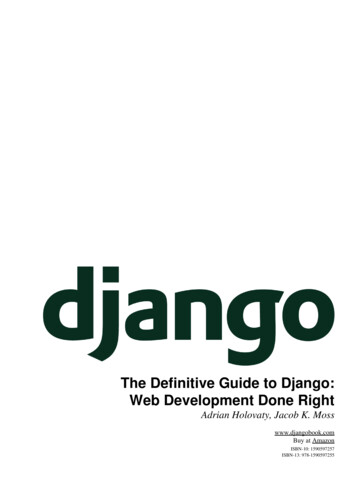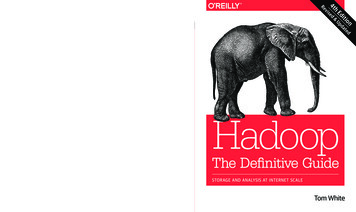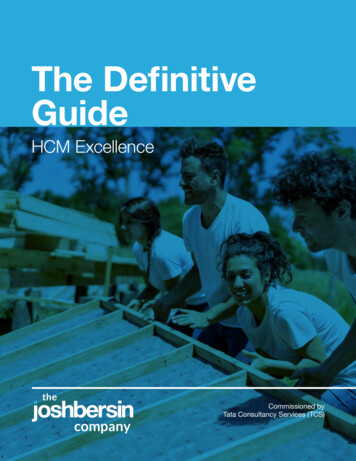
Transcription
The DefinitiveGuideHCM ExcellencethecompanyCommissioned byTata Consultancy Services (TCS)
Contents3Introduction4Chapter 1Why HCM Excellence Matters Now14Chapter 2Where You Stand19Chapter 3Working Solutions36Chapter 4Examples of Excellence57Chapter 5Getting Started72AppendixAll photography: iStock2The Definitive Guide: HCM Excellence Copyright 2021 The Josh Bersin CompanyAll rights reserved. Not for distribution. Licensed material.
IntroductionThe past 18 months have been a period of massive disruption for businesses across the world. Ascompanies rushed to “go digital” to not only hire, manage, support, train, and engage their peoplebut also get work done, we see the ability to reinvent the business model by HR transformation ascritical to thrive in the new normal. In our experience of engaging with customers across industries andgeographies, HR transformation is perhaps the biggest investment made by enterprises in support of theirstrategy. At the same time, it is extremely complex to manage. We feel that customers could leverage andlearn from the experiences of other organizations that have embarked on a transformation journey.TCS is proud to collaborate with The Josh Bersin Company, an independent HR research organizationwith global reach and influence, to launch The Definitive Guide: HCM Excellence, which takes a closerlook into the complexities of HR and HCM transformations. This research engaged customers across theglobe to gather valuable insights and experiences, providing an "outside-in" view of HR market trends andbest practices in HRM deployments, to help companies get more value from HR technology investments.This report, the first in a multipart series on the goals, challenges, and use cases related to HCMsystems, explores how organizations leverage Workday. The series will help organizations accelerateimplementations, take full advantage of the feature sets in their HCM solutions, and offer new ideas andapproaches to further drive project success.We hope HR and technology leaders find this report useful for carrying out successful HR transformationsand exploiting HCM investments to enhance employee experience and achieve strategic objectives.Warm regards,Ram SubramanianGlobal Head, Human Capital PracticeTata Consultancy ServicesThe Definitive Guide: HCM Excellence Copyright 2021 The Josh Bersin CompanyAll rights reserved. Not for distribution. Licensed material.3
14Why HCMExcellenceMatters NowHCM systems have never been more importantor impactful. Our HCM Excellence Frameworkidentifies three elements essential to success.The Definitive Guide: HCM Excellence Copyright 2021 The Josh Bersin CompanyAll rights reserved. Not for distribution. Licensed material.
Driven by the pandemic, companies of all sizes have for the pastyear relied on digital platforms to hire, manage, support, train,and continuously engage their people. In fact, one of the biggestthemes of 2021 has been “digital adoption,” as nearly every businessrelied on video meetings, email, and online platforms for humancapital management (HCM). However, the pandemic did not allowcompanies any time to “learn” these new systems. That’s why HCMsystems of the future have to be ready to use, productive from dayone, and easy to change and adapt.Key Insights The dramatic shift in work habits forced on companies bythe pandemic has put a spotlight on HCM systems. While organizations regard HCM as a priority and there'sno shortage of vendors offering highly integrated systemsto transform employee experience, there's a big gapbetween expectations and reality. Our HCM Excellence Framework identifies threeelements essential to success: Strategy and Governance,Operations and Implementation, and Transformationand Change.The Definitive Guide: HCM Excellence Copyright 2021 The Josh Bersin CompanyAll rights reserved. Not for distribution. Licensed material.5
The HR function had to adapt as well. In 2021, HRteams have worked on cross-functional projectsto implement hybrid work practices, movepeople to new roles, and rapidly hire, onboard,and reskill people who often worked from home.Companies with flexible technology platformscould adapt quickly, while others quickly boughtand implemented new software and are just nowlearning about its capabilities. And central to it allhas been the focus on employee experience.1As businesses recover from the pandemic, theyface another obstacle: hiring. The quits rate, asmeasured by the Bureau of Labor Statistics (BLS),was more than 2.7% in May 2021, pointing outthat 4 million people changed jobs. This new levelof agency in the workforce means employersmust work even harder to make their workplacesattractive, and workers feel more empowered thanever before.The Critical Need forPeople AnalyticsHR departments have been struggling withdata for decades. But now, perhaps for the firsttime, people analytics is a mandate. During thepandemic, companies needed data to identifylocation, stress, work habits, and productivity.Now, companies are monitoring engagement andburnout rates, looking at employee developmentneeds, and using people data for overall businesssurvival. While people analytics used to be a “niceto have,” it is now an essential, and this pushesHCM systems to deliver faster than ever.While many organizations regard a fully functionalpeople analytics function as one of their biggestpriorities, only 17% have one.3 Those using it have?advantage.a hugeOur Employee Experience research clearly showshow important this has become.?Companies creating an“irresistible”1 experience are:5.1 More likely to engage andretain employees2.4 More likely to delightcustomers4.3 More likely to innovateeffectivelyAn “irresistible organization” is a place that employees clamor tojoin and that rivals want to become.Source: The Josh Bersin Company, 20211Yet most companies struggle to create thisCompanies with advanced peopleanalytics are:4.3 More likely to create a senseof belonging4.8 More likely to be seen as agreat place to work7.3 More likely to engage andretain employees2.6 More likely to exceedfinancial targets6.7 More likely to adapt well tochange7.7 More likely to innovateeffectivelyoutstanding experience: 80% of companies arenot powering growth for all employees and leaveSource: The Josh Bersin Company, 2021behind the opportunity to support their people todo their best and be their best.26The Definitive Guide: HCM Excellence Copyright 2021 The Josh Bersin CompanyAll rights reserved. Not for distribution. Licensed material.
The Role of HCM SystemsCloud-based HCM systems have swept acrossbusinesses. Today the cloud HCM market is morethan 8 billion in size as vendors like Workday,Oracle, and SAP SuccessFactors invest heavilyin this growth market. Not only do these systemsmanage payroll and overall employee recordkeeping, but they are now “systems of experience”and “systems of design,” as we describe in TheDefinitive Guide 2021: HR Technology. But despitethe popularity of HCM systems and the massivemarket growth, our research also shows that manyof these systems underdeliver on their promises.Companies start HCM cloud implementations withhigh hopes: making HR more strategic; improvingthe employee experience; and enabling better,more useful people analytics, for example. Butmost fall far short on these expectations: costoverruns are common, milestones are missed, andtwo out of five projects are categorized as failures.In 2019, we conducted a massive study of HRtechnology projects (with more than 700 globalrespondents) and found:15% of companies feel the project fullyO Onlyachieved their intended goals.O Only 22% adhered to their cost budgets.11% believe they had the intendedO Onlyimprovement in the employee experience.While these numbers are disappointing, theproblem is not a lack of hard work. Instead, it’soften a problem of unrealistic or misleadingexpectations (Figure 1). HCM vendors tend tosell a vision for a highly integrated, productive,transformational employee experience. But thereality is that these are very complex enterpriseresource planning (ERP) and workflow systems,and they have to be configured, designed, andimplemented well.HCM implementation “projects” should not bethought of as “projects” but instead as continuoustechnology transformations that endure longinto the future. Workday clients, for example,look at their initial “go-live” date as an importantmilestone, but as all our clients tell us, this isonly the beginning of a great deal of operational,transformational, and new-systems work yet tocome. Therefore, one should reflect on the ideathat it is about not only “standing up” a new systembut also embracing a new technology stack, whichwill live with the company for many years.O Only 19% kept to their project timeline.The Definitive Guide: HCM Excellence Copyright 2021 The Josh Bersin CompanyAll rights reserved. Not for distribution. Licensed material.7
FIGURE 1Gap between Expectations and Reality32%53%42%of HR tech projectsare significantly over budgetof projects miss deadlinefor implementationare rated not fully successfulor failed after two yearsMore strategic HR function–57%Increased innovation–53%Better employee experience–50%Less training–44%Lower total cost of ownership–37%Difference betweenexpected value andactual value achievedEase of updates–35%Better data and insights–28%Real-time data–27%–21%Source: The Josh Bersin Company, 20198The Definitive Guide: HCM Excellence Copyright 2021 The Josh Bersin CompanyAll rights reserved. Not for distribution. Licensed material.Consolidated view of employees
Our research found eight golden rules for successful HR tech projects.FIGURE 2Golden Rules for HR Tech Projects12345678Focus on OutcomesAsk a simple question: What do we need to achieve? Leadership teams must understand theirobjectives before signing expensive contracts. Organizations that have clear goals and stick totheir vision are more likely to achieve transformational outcomes.Change Management MattersAs organizations move into a phase of nearly constant change, it is more important than ever toprepare employees for, and support them through, technological upheaval and organizationaltransformation.Invest in IntegrationHR and IT infrastructures continue to become more complex, requiring organizations to clearlydefine and execute system integration needs.Allocate Adequate ResourcesOrganizations must think beyond the bare minimum of resources to implement a technology,allocating the time, budget, and staff resources needed to deliver optimum results.Build on Solid DataData that is not clean or not ready is the most frequently encountered challenge for HR techprojects, underscoring the importance of preparation to allow organizations to implement newsystems and processes.Employee Experience Is the Killer AppThe specific technology or platform is much less important than the experience employeeshave interacting with it; organizational focus on user experience and tools that streamline theexperience are critical to adoption.Bigger Can Be BetterProjects that are expansive in scope and that take advantage of expert support are moresuccessful at driving big impact.Involve the Right PeopleSuccess requires more than just HR involvement; it also requires positive problem-solving with ITand bringing key partners from across the organization into the project.Source: The Josh Bersin Company, 2020The Definitive Guide: HCM Excellence Copyright 2021 The Josh Bersin CompanyAll rights reserved. Not for distribution. Licensed material.9
The HCM ExcellenceFrameworkand Governance. The projectO Strategyfocus, budget, leadership, governance,and vision.and Implementation. TheO Operationsproject management, architecture, processIn this study, we interviewed 25 large clientsto understand their experiences with Workday.To learn from their experience, we created adesign, and change process.framework that comprises three essential elements(see Figure 3):and Change. ChangesO Transformationin service delivery, operating model,HR structure, and data.FIGURE 3A Framework for HCM ExcellenceStrategy andGovernanceOperations andImplementationTransformationand ChangeFocus on businessoutcomesSimplified technologyecosystemHR transformationStrategy and culturealignmentProject managementand operationsTechnology tapestryTechnology visionProcess redesignPeople analyticsLeadership andgovernanceChange management,training, and adoptionEmployee experienceexcellenceSource: The Josh Bersin Company, 202110The Definitive Guide: HCM Excellence Copyright 2021 The Josh Bersin CompanyAll rights reserved. Not for distribution. Licensed material.
Strategy and GovernanceThe first priority in implementing any project is the strategic vision. Why are you buying this newsystem, and what are the business case and outcomes you need to achieve? Is this a replacement ofone or more current systems with the intent to create a more integrated data solution to drive betterHR and workforce-related decisions? Or is the implementation part of a bigger company or businesstransformation, such as a merger or a restructuring? Or perhaps the implementation is meant to helpdrive better employee experiences? Or is this a system to improve recruiting, learning, or other particularprocesses?For strategic excellence, the following dimensionsneed to be addressed:Strategy and Culture AlignmentDoes your company have a “get-it-done” cultureor is it one of creative design and future vision?Focus on Business OutcomesHow quickly will decisions have to be made andThe business value and success criteria you aimwhat level of iteration can you tolerate? Do youto accomplish with the implementation, and howneed to create stakeholder teams around theit adds value to the company’s business overall,world to “buy in” to various decisions, or will theyare crucial. Defining what success looks like isbe made by senior center-of-excellence leaderskey. On-time and on-budget implementationbased on central control? The most successfulis important, but if the plan is to also improveHCM implementations involve many stakeholdersthe experience, enable HR transformation, oralong the way, but your culture must supportimprove data and analytics, these objectivesthis process.need to be defined up front, measured, andcontinuously tracked.Technology VisionThis dimension is defined by the stated directionWhat is the business case for this massiveand end goals for the overall HR technology stackinvestment? Most new HCM systems cost manyand how the HCM system fits in—including amillions of dollars and affect the operating work forshort-term, medium-term, and long-term visionthousands of people. Is this project justified basedfor various phases of HCM adoption. A visualon process improvement, employee experience,blueprint is a good tool to demonstrate the visiondata, or another goal?for the technology architecture, supported by avision statement, and the team should develop aWhat is the budget and how was it derived? Didthree- to five-year plan.you benchmark with other companies or ask yourstrategic implementation partner for a fixed bid?Leadership and GovernanceIs there a shared-risk model with the supplier orBringing together a capable, engaged team, withconsulting firm? How many people and externalagile leadership and clear roles, decision rights,systems and consultants are going to be required?the role of partners, any trade-offs (in terms ofemployee time, business priorities, and budget),This business case not only brings the CFO andwho will own responsibility for the implementationCIO into the project, it forces the team to create aitself, and ongoing solution management are keygovernance process so a set of senior executivesparts of this factor. There should be a hierarchy ofbecomes committed to success. HR or IT cannotdecision-makers, so local teams can move quicklyimplement these systems alone—a strong seniorand top management can buy off easily.leadership team must be involved.The Definitive Guide: HCM Excellence Copyright 2021 The Josh Bersin CompanyAll rights reserved. Not for distribution. Licensed material.11
Operations and ImplementationThis element is all about focusing on what is needed for project execution and setting up forpostimplementation success. This work encompasses the activities necessary to implement thetechnology in the company ecosystem, manage the change journey, optimize the processes involved,and support change management. New roles and responsibilities will likely need to be created andassigned to the organization that will manage the HCM solution going forward.The dimensions of operational excellenceprocesses in the system. This should include ain HCM are:design-thinking process, a look at user personas,and a serious look at the configurability andSimplified Technology Ecosystemprocess options inherent in the system.“Workday does not exist in a vacuum,” an HRtechnology leader said. All HR technologiesWorkday, for example, is designed to “work as is”need to be synchronized and integrated so theyout of the box. But most companies find it is hardwork together seamlessly. A simpler technologyto use or difficult to learn, so they build “journeys”ecosystem is good because it costs less, makesaround it—using Workday’s People Experiencemaintenance and integrations easier, reducesor other journey aids, or tools from ServiceNow,errors, and creates a better experience forMicrosoft Viva, or others.employees and leaders.Each and every process, from sourcing toProject Management and Operationsrecruiting to onboarding to time and attendance,Project management is the daily work to manageneeds a process view—so consultants often workthe HCM system implementation and operate itwith you to make sure you think these through andeffectively going forward. After implementation,use the system at its best. This process takes timethis includes the oversight required to ensureand it’s important that these design teams staysuccessful day-to-day operation of the newintact during and after implementation.solution and regular checks against leadingpractices—including release management andChange Management, Training, and Adoptionoptimization. Cross-functional collaborationFor excellent HCM transformation, people needbetween HR and IT is critical to operate thenew ways of working. Effectively communicatingHCM system and adopt technology capabilitiesand training and empowering stakeholders aresuccessfully.fundamental to enabling new capability andcapacity in the organization. End users of the HCMProcess Redesignsystem—employees, managers, leaders, and HRNew systems bring lots of opportunity forpeople—need to adopt the new processes to beimprovement. The most important of all is toable to use the capabilities provided by the system.simplify and improve all the various people12The Definitive Guide: HCM Excellence Copyright 2021 The Josh Bersin CompanyAll rights reserved. Not for distribution. Licensed material.
Transformation and ChangeThe third element of the framework is the most interesting of all: How will you change your company’soperations to best leverage this new system? Will self-service transform the role of the HR businesspartners? Will recruiters have a vastly different job? What will you do with all the integrated dataand analytics?HR Transformationmore engaging, help people be more productive,HR work, roles, capabilities, and operatingand remove barriers to success is critical inmodels have to change in order for an HCMHCM implementations and maximizing HCMimplementation to deliver on its promise.investments. This requires a laser focus on the wayConsiderations include current and futureemployees engage with the HCM system, makingcapabilities, new organization models, and how tothings easy and useful for them.bridge current and future states to enable a morestrategic HR organization.technologies in the road map? Are you movingHCM ExcellenceIs a Journeyto an “all-Microsoft” world or a deep integrationRather than thinking of an HCM project asTechnology TapestryWhat is the long-range vision for newwith ServiceNow, Salesforce, or other majorsystems? This should be part of the long-termtransformation—and we encourage you to thinkbig here. New technologies like chatbots, AI, talentintelligence systems, and virtual reality are comingfaster than you think.People AnalyticsHCM solutions generate volumes of employeerelated data. Turning data into actionableinsights is critical to success. However, too manycompanies are not equipped with the resourcesand skills required for the analysis and meaningfulreporting of this data. Using HCM-generatedinformation to provide insights and ultimately makedecisions is what will drive meeting expectationsand delivering actual business outcomes.Employee Experience ExcellenceTransforming the employee experience to besomething with a “start” and an “end,” think aboutit as being like buying a new house. You mustfurnish it, perhaps fix a few layout problems, buynew lighting and window coverings, and then movein. And as soon as you move in, you find all sortsof surprises—the stairs to the basement are a littlesmall, the air conditioner isn’t as strong as you hadhoped, and so on. You start a new life in this newhouse, and you adapt and fix and improve thingsover time.An HCM implementation is similar. In the olddays, we “implemented” these systems and thenmoved on to another IT project. Today, sincethe platforms are hosted by the vendor and aresignificantly upgraded several times a year, you are“living with this vendor,” so you need to design theimplementation for long-term success. And this iswhy we put together a maturity model to help.The Definitive Guide: HCM Excellence Copyright 2021 The Josh Bersin CompanyAll rights reserved. Not for distribution. Licensed material. 13
214WhereYou StandAchieving HCM excellence is a journey.The HCM Maturity Model helps companiesunderstand where they are and how successfulorganizations advance.The Definitive Guide: HCM Excellence Copyright 2021 The Josh Bersin CompanyAll rights reserved. Not for distribution. Licensed material.
Trends emerge when you examine companies that implementWorkday and other HCM systems. These findings inform our HCMMaturity Model, which allows organizations to determine where theystand—and offers a path to mature over time, depending on theircommitment and level of investment.Key Insights O ur research with leading companies identified cleartrends driving HCM excellence. The HCM Maturity Model helps organizations understandwhere they stand and offers a path for maturing over time,depending on commitment and level of investment. There are six phases in the HCM Excellence Lifecycle,providing “mini-projects” around which organizations canadvance their transformations.The Definitive Guide: HCM Excellence Copyright 2021 The Josh Bersin CompanyAll rights reserved. Not for distribution. Licensed material.15
FIGURE 4The HCM Maturity ModelLEVEL4LEVEL3LEVEL2LEVEL1Business TransformationFocus on people, design thinking, journey maps, and HR capabilitiesBalance operational, strategic, and transformation excellenceOutcome-DrivenFocus on business outcomes, success criteria, and strategy alignmentBalance operational and strategic excellenceProcess-FocusedFocus on processes, procedures, and transactions, often with waterfall approachesOperational efficiency is most important, but without a strategic groundingTechnology-CenteredFocus on installing a technical system, automating processes, and reducing costs, without muchconsideration for process or people aspectsSource: The Josh Bersin Company, 2021The HCM ExcellenceMaturity ModelBased on many months of interviews anddiscussions, we developed a four-level maturitymodel for HCM excellence. Each company willfit into one of these levels, with progressivelyincreasing capabilities.don’t think ahead to determine what data wouldbe needed to inform people of those choicesor how to leverage the HCM to transform theway employees work. Level 1 companies mayhit their short-term cost reduction targets byconsolidating systems but likely won’t accomplishbroader, more strategic outcomes. Often, theseHCM implementations are driven by IT, withperipheral involvement of HR and little to no directinvolvement of employees and managers. Most ofLevel 1: Technology-CenteredAt Level 1, companies focus on implementationfrom a technology perspective (Figure 4). Whileimplementation teams spend time and effort ontechnical configuration decisions, they typically16these companies port over legacy processes in thenew HCM environment—and with that, they leavethe enormous upside benefits of HCM systemson the table. These are often called “slammed in”projects with very rapid implementations, and tendto miss data integration, payroll, and other issues,which are addressed later after go-live.The Definitive Guide: HCM Excellence Copyright 2021 The Josh Bersin CompanyAll rights reserved. Not for distribution. Licensed material.
Level 2: Process-FocusedAt Level 2, companies apply significant effortbut some companies include these issues fromthe start.to process design. In addition to bringing ITresources into the implementation, teams includefunctional HR experts to redesign transactions andprocesses. They often apply a waterfall approachto the process and technology design—and thusthey miss the opportunity to drive strategic impact.Once the HCM implementation is complete, teams(and leaders) often wonder why employees arehaving difficulty using the system, or why they’renot getting the data and associated insightsexpected. Moving to the next level requires a morestrategic focus and prioritization of what is reallyThe HCM ExcellenceLifecycleMethodologies vary, but in essence, each HCMtransformation advances through six phases(Figure 5). Understanding these phases isimportant as they each involve distinct activitiesand deliverables and can serve as “mini-projects”to structure the program around.important to the business, so processes can betailored to the business and cultural needs.Level 3: Outcome-DrivenFIGURE 5The HCM Excellence LifecycleLevel 3 companies define success criteria,business outcomes, and alignment with theirbusiness strategy at the very beginning ofimplementation projects. They balance operationalPlanand strategic excellence and hit these targetswell: cost reduction, system consolidation, andstreamlining of processes. They also get betterImproveworkforce-related insights because they designprocesses and customize the technology expresslyHCMExcellenceLifecycleDesignto provide the data and analytics that will powerbetter business decisions. These companies drivethe HCM implementation through an experiencedImplementPrototypeHR team that has a close partnership with IT. Toadvance to the next level, companies need to addTesta focus on people and experience with practiceslike design thinking and journey maps, and involveemployees and managers directly in the design.Source: The Josh Bersin Company, 2021Level 4: Business TransformationAt Level 4, the HCM system is a tool for long-termbusiness transformation. The company considersthis an opportunity to change the way HR operates,change and improve the employee experience, andpossibly change the way contractors, employees,and others are managed. In most implementationsthese kinds of issues come postimplementation,PlanThis phase incorporates determining the approachto the project, assembling a team, identifyingkey partners, and establishing work proceduresand collaboration patterns. Activities includedeveloping a project charter, documenting theThe Definitive Guide: HCM Excellence Copyright 2021 The Josh Bersin CompanyAll rights reserved. Not for distribution. Licensed material.17
vision, and establishing objectives. A detailed taskincorporate new data and insights into workflowsplan will also be completed to outline each phase,for managers and HR.set start and completion dates, identify expectedaccomplishments, and define success measures.HCM excellence depends on understanding thesephases and working through them in an iterativeDesignway. In reality, HCM transformation is often nota linear progression through the phases; forAn end-to-end experience design encompasses ainstance, an issue discovered during prototypingwide range of work, from the step-by-step designmay require additional design work. Or, when theof key transactions to the rethinking of roles, data,business environment changes midway throughprocesses involved, and even organizationalan implementation project—as it did during thestructures.COVID-19 crisis, for example—the plan, strategy,and success measures, as well as staffing, mayPrototypehave to be reexamined.This is the phase in which an initial build of theAnd HCM excellence doesn’t stop when thesystem is completed. The prototype is based onsystem is implemented initially. Think about theexperience design and the decisions that factor intoHCM system as the infrastructure backbone forthe system’s configuration. This phase also includesyour people-related systems. HCM excellencethe system integrations needed to make the HCMdepends on a continuous-improvement approach,part of the company’s technology ecosystem.iterating through these phases even for ongoingTestand transformational elements.releases—and balancing strategic, operational,In this phase, testing cycles are performed toensure the system is working as expected. Thephase typically includes unit, system-integration,and parallel testing, along with user review andConclusionacceptance testing. Each type of test should haveOne of the best ways to improve organizationaldetailed checklists and unique criteria for qualitypractices is to learn from the successesassurance.and failures of others that have been there.Many companies have embarked on HCMImplementWhen it’s time to move the
1An irresistible organiation is a lace that emloees clamor to oin and that rivals ant to become. ource he osh ersin oman Companies creating an "irresistible"1 experience are: More liely to engage an retain employees More liely to elight cstomers 5.1 2.4 More liely to innoate 4.3 eectiely? ource he osh ersin oman Companies with .

